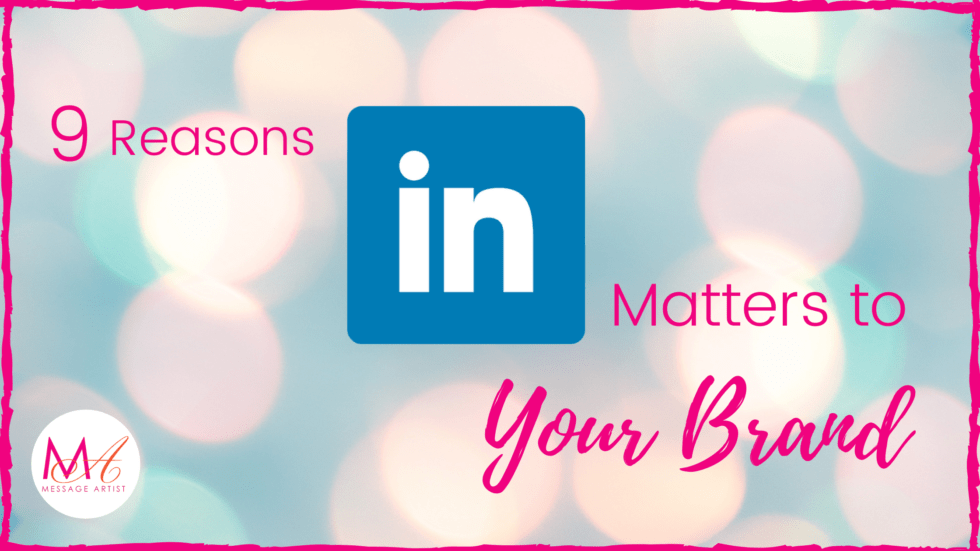In my last blog post, Ensure Your Social Presence Supports Your Brand, I talked about how to use social platforms to support your brand. Today, I want to talk specifically about why — even if you’re not on any other social platform — it’s important for your business or personal brand to have a LinkedIn profile.
Each social platform has its pros and cons and reasons to use it or not. Here are 9 reasons why LinkedIn needs to be part of your brand and marketing strategy.
1) Showcase Your Brand
To begin, when anyone Google’s someone’s name, most people’s LinkedIn profile shows up at the top of the search results. An up-to-date profile can help you make that all important first impression — personally or as a business owner.
Creating and consistently publishing rich, relevant content that showcases your expertise allows you, over time, to become known as a thought leader in your industry. Your goal should be to post content with which people actually engage, preferably with comments and at least likes and shares. The LinkedIn algorithm favors comments and rewards posts with comments by showing it to more people. The order of algorithm preference is:
- Video content (definitely dominates for attention and engagement)
- Text-only posts
- Text posts with images
- The least favored content is anything with a link that takes people off the site. Like all social platforms, LinkedIn wants to keep you on their site as long as possible — avoid outbound linking overly much.
Don’t forget to take time and engage with others’ posts. Share your knowledge and experience gained in life and business. Providing value to network can drastically improve how you are perceived. LinkedIn provides a great, highly visible platform for helping you stand out as a leader in your market space.
2) Educate and nurture potential clients
LinkedIn is fantastic way to educate your potential clients and customers about the what, why, and how you do what you do. It is a platform in which you can talk about your products and services, share thought leadership articles, or tips that highlight your expertise. Just like on your own website, it’s another way to show your prospective customers how you solve problems.
I’ll repeat, make sure to engage with the individuals and organizations with whom you’d like to establish a business relationship. When you take the time to build trust and showcase your expertise and ability to solve their problems, you will pique interest and have them visiting your website to learn more.
3) Search Engine Optimization
LinkedIn profiles (company & individual) are ranked with high optimization on Google. This means that just having a LinkedIn profile will put you higher on the results page when someone searches your company name or your industry.
If you’re a micro business (less than 5 employees) or solo entrepreneur, you don’t really need to establish a company page. It makes more sense to be active with your personal profile, on which your business is linked. If you have a larger business and employees to help manage tasks, having a company LinkedIn page makes sense. Either way, Google loves LinkedIn, so don’t miss this chance to be found!
4) Networking
LinkedIn allows us to connect with people who may have been inaccessible in the past. With first, second, and third degree “connections,” LinkedIn becomes a great networking tool. You can give and receive introductions to people and greatly expand your professional network. Simply put, it removes some barriers to researching companies and building the new relationships that can help your business grow.
5) Find New Talent Partners & Employees
Connect with those you suspect might make a good collaboration partner and develop a relationship. And when you do connect, take time to correspond — WITHOUT PITCHING. Suggest a short virtual meeting or call. Take time to get to know each other and learn more about each other’s business. This open, helpful approach can open up many doors to future projects, customers, or opportunities.
With its advanced search tool and suggested connections, LinkedIn can be a great resource when you’re looking for new talent. Direct messaging with connections or asking for an introduction is always better than a cold connection! If you have a paid LinkedIn account, you can even see who is looking at your profile, which can be helpful in finding prospective employees or collaboration partners.
Additionally, with the LinkedIn Job Search app, it’s pretty easy to recruit new people; just post the job to LinkedIn. When you review prospective candidates, LinkedIn profiles reveal valuable information, including stability, record of successful accomplishments, and passion for what they do.
6) Launch New Product & Service Offerings
Some of the top reasons people follow brands on social media are: promotions and discounts, latest products information, customer service, entertaining content, and ability to offer feedback. More than half of vendors say they have generated sales through LinkedIn.
With LinkedIn company pages, you can introduce new products or services while highlighting the benefits to your customers. And, of course, you provide links to your website enabling readers to easily obtain more information — and then convert your website visitors into warm leads.
7) Check Out the Competition
According to the Content Marketing Institute, 94% of B2B marketers use LinkedIn to distribute content. This makes it the social media platform used most often by business owners. Monitor changes in your industry and track what your competition has accomplished by visiting the company pages of businesses serving your target market.
Noting employee transitions and monitoring the social media strategies of other companies offering similar services or products can help you identify trends and opportunities for talent acquisition and/or growth areas.
8) Social Proof
LinkedIn provides a great platform to highlight your unique value and differentiate yourself from others offering similar products or services. Gain social proof for your skills and talents when others recommend or endorse you. Showing you have other experts backing up your claims about your skills and expertise paints you in a favorable light.
Also, you can use your company description and/or your About section to emphasize how you stand out. On your company page, be sure to include company news and share information about your company culture. This helps reach potential new talent and convey your company’s values, mission, and vision. Use stories, infographics, and photos to provide an authentic, transparent, and positive impression of your brand. This helps give an impression about how your and your company thinks and acts.
9) Measurement
One of the most crucial elements of a marketing strategy is ongoing measurement and optimization. No matter which tactics you use, you can almost always improve. Most social sites offer levels of analytics, and LinkedIn is no exception. With their analytical tools, you can track who is interacting with your content and how. You can do some A/B testing of different images, headlines, copy, and more to finetune your approach. When you use the analytical data, it helps ensure your marketing strategy meets the needs of your brand.
Don’t Forget …
Make sure your visuals support your personal and professional brand! That means having a professional headshot, and that your logo and cover image are of good quality. Read my last blog for tips on how to do this.
If you need help getting your LinkedIn profile and/or company page aligned with your brand, I can help. Schedule a chat with me or pop me an email. Let’s see how I can help you put your best social self forward.




0 Comments